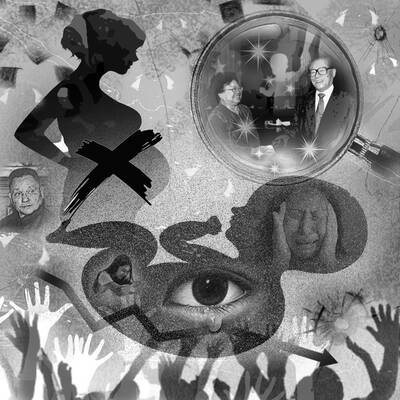All China’s strategies to invade Taiwan are directed at what Beijing perceives to be the fundamental problem preventing unification: Taiwanese identity.
Interference in Taiwan’s education has always been considered key to resolving the nation’s identity problem. In 2008 then-Chinese president Hu Jintao (胡錦濤) made six Taiwan policy proposals, known as “Hu’s six points.” The first of these points stresses the “one China” doctrine and the second stresses a “one China” market. They are followed by the foundation of a national identity that comes as a result of closer political and economic integration: Promoting Chinese culture and tightening spiritual bonds.
Then-Chinese Nationalist Party (KMT) deputy chairman John Kuan (關中), while attending a Taiwan Week activity in Hubei Province, summed up the KMT’s intentions by saying that President Ma Ying-jeou (馬英九) had a “very heavy responsibility” during his first term to change the previous administration’s promotion of desinicization and Taiwanese independence. The focus of Kuan’s statement was that: “This requires the mainland’s [sic] assistance.”
From the beginning, the KMT has asked the Chinese Communist Party (CCP) for help in making Taiwanese education more China-centric. The KMT and CCP have launched long-term talks, likely to involve ideology, which means the KMT is unlikely to act audaciously. The results have not been very smooth.
On Aug. 6, 2012, the international edition of the People’s Daily reported that the two sides of the Taiwan Strait were discussing the signing of a cross-strait cultural and educational exchange and cooperation agreement, which some people have called a cultural and educational version of the Economic Cooperation Framework Agreement, in an attempt to institutionalize cultural and educational collaboration.
When Ma took office, his government blocked what they defined as the “desinicization course guideline” that was introduced by the previous administration and formed a special task force to adjust the curriculum. After four years, the 2012 course guidelines were released. No one could have imagined that only two years later, as much as 60 percent of the Taiwanese history curriculum would be changed through what the government termed “minor corrections” due to “errors” and the need for “corrections” and “constitutional compliance.”
Why suddenly make such major changes? In analyzing events, it should be remembered that last year the student-led Sunflower movement broke out. Since Ma’s re-election two years ago, he has behaved more irrationally, but the seeds for change were planted long ago. China was naturally aware of this and anxiously prepared for the worst: A change in government power.
China previously entered into an “alliance” with the KMT as a means of implementing its unification strategies. However, now that the KMT has lost support, Beijing has not used its influence and network in Taiwan to manage things on its own. This is important when trying to understand the reason for the changes to the finalized course guidelines.
Recently the Taiwan Solidarity Union put forward concrete evidence — a list of all the members on the course guideline task force — and accused the Ministry of Education of being China’s “unification education ministry.” This is evidence that the CCP no longer trusts the KMT and is directly managing education-related affairs, rather than relying on the KMT as the go-between.
Christian Fan Jiang is deputy convener of the Northern Taiwan Society’s legal and political group.
Translated by Zane Kheir
We are used to hearing that whenever something happens, it means Taiwan is about to fall to China. Chinese President Xi Jinping (習近平) cannot change the color of his socks without China experts claiming it means an invasion is imminent. So, it is no surprise that what happened in Venezuela over the weekend triggered the knee-jerk reaction of saying that Taiwan is next. That is not an opinion on whether US President Donald Trump was right to remove Venezuelan President Nicolas Maduro the way he did or if it is good for Venezuela and the world. There are other, more qualified
The immediate response in Taiwan to the extraction of Venezuelan President Nicolas Maduro by the US over the weekend was to say that it was an example of violence by a major power against a smaller nation and that, as such, it gave Chinese President Xi Jinping (習近平) carte blanche to invade Taiwan. That assessment is vastly oversimplistic and, on more sober reflection, likely incorrect. Generally speaking, there are three basic interpretations from commentators in Taiwan. The first is that the US is no longer interested in what is happening beyond its own backyard, and no longer preoccupied with regions in other

Jan. 1 marks a decade since China repealed its one-child policy. Just 10 days before, Peng Peiyun (彭珮雲), who long oversaw the often-brutal enforcement of China’s family-planning rules, died at the age of 96, having never been held accountable for her actions. Obituaries praised Peng for being “reform-minded,” even though, in practice, she only perpetuated an utterly inhumane policy, whose consequences have barely begun to materialize. It was Vice Premier Chen Muhua (陳慕華) who first proposed the one-child policy in 1979, with the endorsement of China’s then-top leaders, Chen Yun (陳雲) and Deng Xiaoping (鄧小平), as a means of avoiding the
As technological change sweeps across the world, the focus of education has undergone an inevitable shift toward artificial intelligence (AI) and digital learning. However, the HundrED Global Collection 2026 report has a message that Taiwanese society and education policymakers would do well to reflect on. In the age of AI, the scarcest resource in education is not advanced computing power, but people; and the most urgent global educational crisis is not technological backwardness, but teacher well-being and retention. Covering 52 countries, the report from HundrED, a Finnish nonprofit that reviews and compiles innovative solutions in education from around the world, highlights a